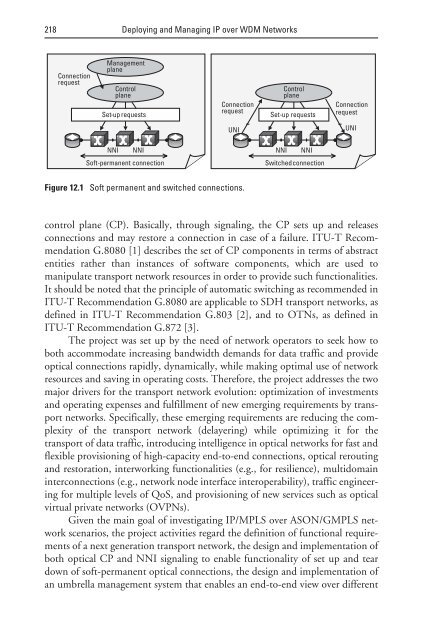deploying and managing ip over wdm networks - Index of
deploying and managing ip over wdm networks - Index of
deploying and managing ip over wdm networks - Index of
Create successful ePaper yourself
Turn your PDF publications into a flip-book with our unique Google optimized e-Paper software.
218 Deploying <strong>and</strong> Managing IP <strong>over</strong> WDM Networks<br />
Connection<br />
request<br />
Management<br />
plane<br />
Control<br />
plane<br />
Set-up requests<br />
NNI NNI<br />
S<strong>of</strong>t-permanent connection<br />
Connection<br />
request<br />
Control<br />
plane<br />
Set-up requests<br />
NNI NNI<br />
Switchedconnection<br />
Connection<br />
request<br />
control plane (CP). Basically, through signaling, the CP sets up <strong>and</strong> releases<br />
connections <strong>and</strong> may restore a connection in case <strong>of</strong> a failure. ITU-T Recommendation<br />
G.8080 [1] describes the set <strong>of</strong> CP components in terms <strong>of</strong> abstract<br />
entities rather than instances <strong>of</strong> s<strong>of</strong>tware components, which are used to<br />
man<strong>ip</strong>ulate transport network resources in order to provide such functionalities.<br />
It should be noted that the princ<strong>ip</strong>le <strong>of</strong> automatic switching as recommended in<br />
ITU-T Recommendation G.8080 are applicable to SDH transport <strong>networks</strong>, as<br />
defined in ITU-T Recommendation G.803 [2], <strong>and</strong> to OTNs, as defined in<br />
ITU-T Recommendation G.872 [3].<br />
The project was set up by the need <strong>of</strong> network operators to seek how to<br />
both accommodate increasing b<strong>and</strong>width dem<strong>and</strong>s for data traffic <strong>and</strong> provide<br />
optical connections rapidly, dynamically, while making optimal use <strong>of</strong> network<br />
resources <strong>and</strong> saving in operating costs. Therefore, the project addresses the two<br />
major drivers for the transport network evolution: optimization <strong>of</strong> investments<br />
<strong>and</strong> operating expenses <strong>and</strong> fulfillment <strong>of</strong> new emerging requirements by transport<br />
<strong>networks</strong>. Specifically, these emerging requirements are reducing the complexity<br />
<strong>of</strong> the transport network (delayering) while optimizing it for the<br />
transport <strong>of</strong> data traffic, introducing intelligence in optical <strong>networks</strong> for fast <strong>and</strong><br />
flexible provisioning <strong>of</strong> high-capacity end-to-end connections, optical rerouting<br />
<strong>and</strong> restoration, interworking functionalities (e.g., for resilience), multidomain<br />
interconnections (e.g., network node interface interoperability), traffic engineering<br />
for mult<strong>ip</strong>le levels <strong>of</strong> QoS, <strong>and</strong> provisioning <strong>of</strong> new services such as optical<br />
virtual private <strong>networks</strong> (OVPNs).<br />
Given the main goal <strong>of</strong> investigating IP/MPLS <strong>over</strong> ASON/GMPLS network<br />
scenarios, the project activities regard the definition <strong>of</strong> functional requirements<br />
<strong>of</strong> a next generation transport network, the design <strong>and</strong> implementation <strong>of</strong><br />
both optical CP <strong>and</strong> NNI signaling to enable functionality <strong>of</strong> set up <strong>and</strong> tear<br />
down <strong>of</strong> s<strong>of</strong>t-permanent optical connections, the design <strong>and</strong> implementation <strong>of</strong><br />
an umbrella management system that enables an end-to-end view <strong>over</strong> different<br />
UNI<br />
Figure 12.1 S<strong>of</strong>t permanent <strong>and</strong> switched connections.<br />
UNI


